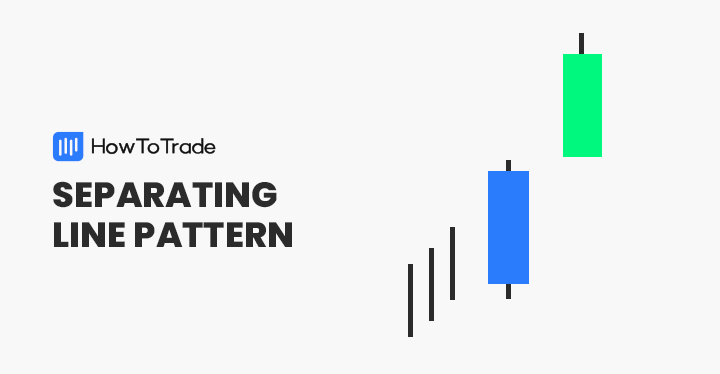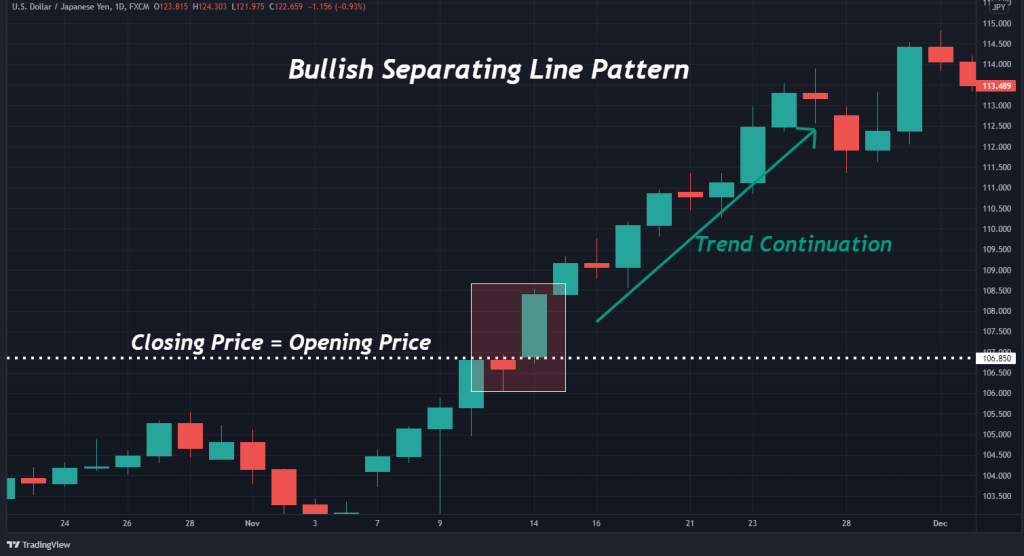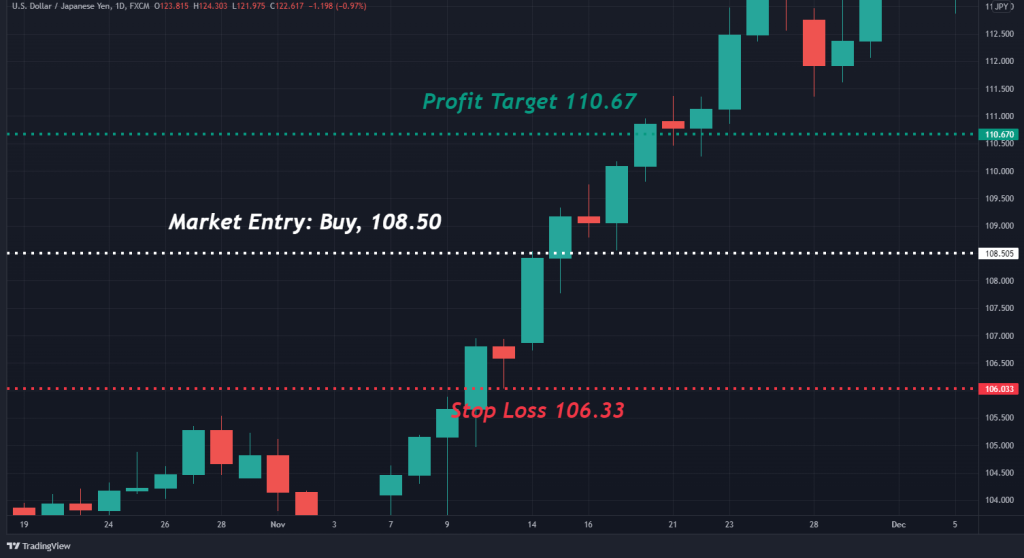
Are you familiar with the separating lines pattern? If not, keep reading! In this article, we’ll show you how to recognize, interpret, and trade this powerful chart formation. By the end, you’ll be able to incorporate the separating lines pattern into your trading strategy.
 Table of Contents
Table of Contents
What is the Separating Line Candlestick Pattern?
The separating line candlestick pattern is a two-candle chart formation that signals trend continuation. Thus, it is classified as a continuation pattern and a trend-following indicator. It is part of a very limited two-candle chart formation group that includes the piercing line pattern, tweezer top pattern, etc.
The separating lines pattern comes in two types: bullish and bearish. Forex traders and Forex market participants view this candlestick pattern as a potential opportunity to buy or sell a currency pair.
How to Identify the Separating Line Pattern in Trading?
One of the best things about using Japanese candlestick patterns to craft trading decisions is that they may be routinely recognized. Once identified, applying a trading strategy is a straightforward process. The chart below gives us a clear look at a bullish separating lines pattern.

Here’s how a separating line formation is used:
- A bearish or bullish trend is identified.
- The two-candle sequence (bullish/bearish or bearish/bullish) is highlighted.
- A market “break” is observed.
- A long or short position is opened with the trend.
Recognition
Recognizing the separating lines candlestick pattern in real-time is simple. Upon spotting a pronounced uptrend or downtrend, one may search for the two-candle setup.
Separating lines consist of two candles that feature contrasting colors. Additionally, the first candle’s closing price is identical to the second candle’s opening price.
Bullish Separating Lines Pattern
The bullish separating line pattern occurs during an uptrend in price and is a signal to buy the market. It appears as follows:
- The first candle is negative.
- The second candle is a significant, positive candle.
- The closing price of the first candle is equal to the opening price of the second candle.

Bearish Separating Lines
The bearish separating lines pattern develops during a downtrend in price and is a signal to sell the market. It consists of the following attributes:
- The first candle is positive.
- The second candle is a more significant negative candle.
- The closing price of the first candle is equal to the opening price of the second candle.

How to Trade the Separating Line Candlestick Pattern?
The trading process for the bullish separating lines candlestick and bearish separating lines candlestick is straightforward. All you need to do is identify a market entry point, stop loss, and profit target location.
1. Market Entry
Deciding upon an ideal market entry will depend on whether you are trading the bearish or bullish separating lines signal. However, both are continuation patterns, so you will be buying or selling with the prevailing trend.
Here’s how:
- Bullish: A bullish separating lines candle develops during an uptrend. Market entry is a buy above the second bullish candlestick of the pattern.
- Bearish: The bearish separating line occurs amid a downtrend. Market entry is a sell below the second bearish candlestick of the formation.
2. Stop Loss
Locating a stop loss with the formation of the separating line is simple. It is set above or beneath the pattern as follows:
- Bullish: The stop loss is placed beneath the first bearish candle of the pattern. This protects the long position from undue retracement.
- Bearish: The stop loss is placed above the first bullish candlestick of the pattern. This protects the short position from a movement in price significantly upward.
3. Profit Target
In forex, profit targets are placed upon the market in various ways when a trading chart formation, pattern height, and risk vs. reward ratios are two of the most common. Generally speaking, profit targets for the separating lines patterns are placed as follows:
- Bullish: Profit targets are placed above the upper extreme of the bullish separating lines candle.
- Bearish: Profit targets are placed beneath the lower extreme of the bearish separating lines candlestick.
The trader can capitalize on bullish or bearish trends following candle gaps by placing profit targets in these fashions.
Here’s an example of the operating line pattern:
One of the best things about trading separating lines is that getting in the market ahead of a hollow or black candle continuation can be exceedingly profitable. The USD/JPY example below gives an in-depth look at how this may be done.

This USD/JPY trade was executed as follows:
- A strong bullish trend was spotted.
- The bullish separating lines pattern was identified. It comprised an initial bearish candle and a subsequent bullish candle with an identical close and open.
- Buy order was placed above the second candle at 108.50.
- A stop-loss was located below the first candle at 106.33.
- A profit target was placed at 110.67, according to a 1:1 risk vs. reward ratio.
- Upon the profit target being hit, a 217 pip gain was realized.
The Separating Line Chart Pattern – Pros and Cons
These are the most common pros and cons of trading the separating line chart pattern:
Pros
- It offers the trader opportunities to buy or sell a market
- Extraordinary profits are possible when trading solid trends
- Identifying the pattern in real-time is straightforward
Cons
- It can produce false signals when occurring in weak trends
- Not commonly found in forex pairs
- Features a reduced efficacy on lower timeframes
Key Takeaways
In conclusion, here are the key takeaways:
 Key Points to Take Away
Key Points to Take Away
- The separating lines pattern is classified as a trend continuation indicator. It consists of two candlesticks with the same closing and opening prices
- There are two types of separating lines patterns: bullish and bearish. Bullish separating lines develop during uptrends; bearish occur during downtrends
- To trade the bullish separating lines, one buys above the second candle of the pattern. To trade the bearish, one sells beneath the second candle of the indicator
Frequently Asked Questions (FAQs)
The following are a few of the most frequently asked questions regarding separating lines.
Are separating line patterns reliable continuation indicators?
Yes. However, they’re not infallible. When trading the separating lines, be sure to implement prudent risk management.
Can I use the formation to trade forex, CFD, futures, and shares?
Yes. The separating lines pattern periodically occurs in all markets.
Do I need to use a stop loss when trading the separating lines continuation pattern?
It is recommended that a mental or hard stop loss is used when trading the formation as well as a predefined risk-reward ratio. A stop-loss can save you from financial catastrophe in a market reversal!
Risk Disclosure: The information provided in this article is not intended to give financial advice, recommend investments, guarantee profits, or shield you from losses. Our content is only for informational purposes and to help you understand the risks and complexity of these markets by providing objective analysis. Before trading, carefully consider your experience, financial goals, and risk tolerance. Trading involves significant potential for financial loss and isn't suitable for everyone.



